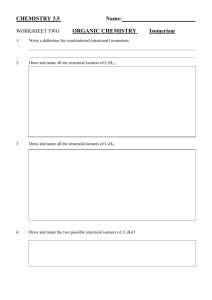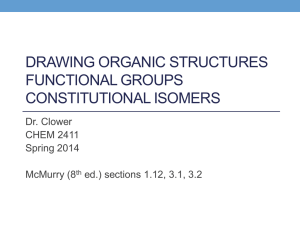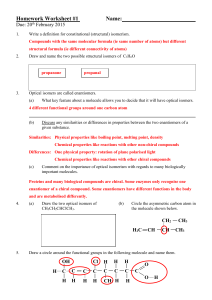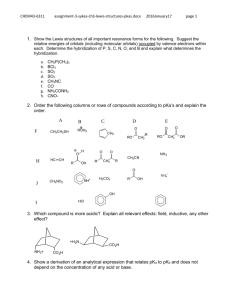OChem ACS Review 2 Alkanes
advertisement
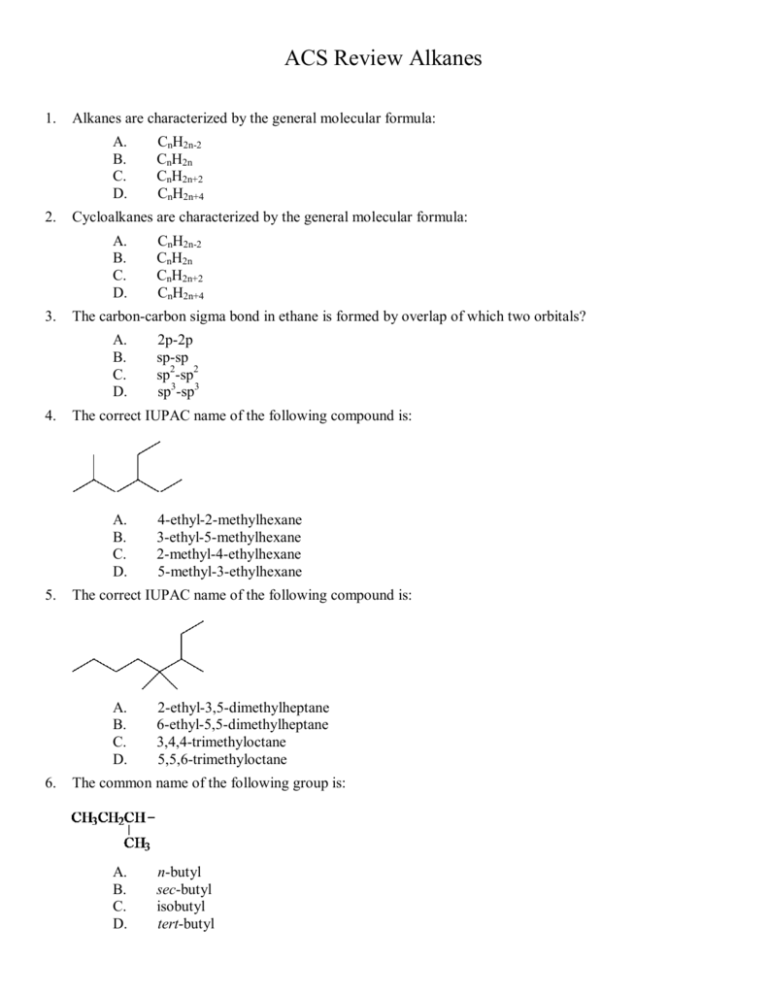
ACS Review Alkanes 1. Alkanes are characterized by the general molecular formula: A. B. C. D. 2. Cycloalkanes are characterized by the general molecular formula: A. B. C. D. 3. 4-ethyl-2-methylhexane 3-ethyl-5-methylhexane 2-methyl-4-ethylhexane 5-methyl-3-ethylhexane The correct IUPAC name of the following compound is: A. B. C. D. 6. 2p-2p sp-sp sp2-sp2 sp3-sp3 The correct IUPAC name of the following compound is: A. B. C. D. 5. CnH2n-2 CnH2n CnH2n+2 CnH2n+4 The carbon-carbon sigma bond in ethane is formed by overlap of which two orbitals? A. B. C. D. 4. CnH2n-2 CnH2n CnH2n+2 CnH2n+4 2-ethyl-3,5-dimethylheptane 6-ethyl-5,5-dimethylheptane 3,4,4-trimethyloctane 5,5,6-trimethyloctane The common name of the following group is: A. B. C. D. n-butyl sec-butyl isobutyl tert-butyl 7. Which one of the following is 2,2,5-trimethylhexane? A. B. C. D. 8. The correct IUPAC name of the following is: A. B. C. D. 9. (CH3)2CHCH2C(CH3)3 (CH3)2CHCH2CH2C(CH3)3 CH3CH2CH(CH3)C(CH3)3 (CH3)2CHCH2 CH2CH2C(CH3)3 2,4,7-trimethylnonane 3,6,8-trimethylnonane 7-ethyl-2,4-dimethyloctane 2-ethyl-5,7-dimethyloctane Which one of the following is tert-butyl chloride? A. B. C. D. CH3CH2CH2CH2Cl CH3CH2CHClCH3 (CH3)2CHCH2Cl (CH3)3CCl 10. What is the IUPAC name of the following? A. B. C. D. 1-ethyl-4.4-dimethylcyclopentane 1-ethyl-3,3-dimethylcyclopentane 3-ethyl-1,1-dimethylcyclopentane 4-ethyl-1,1-dimethylcyclopentane 11. Cyclohexane is composed of: A. B. C. D. methine groups. methylene groups. methyl groups. both methine and methylene groups. 12. All the carbons in cyclopentane are: A. B. C. D. primary carbons. secondary carbons. tertiary carbons. quaternary carbons. 13. The correct name of the following compound is: A. B. C. D. (1-methylpropyl)cyclohexane (2-methylpropyl)cyclohexane (2,2-dimethylethyl)cyclohexane (2,2-dimethylpropyl)cyclohexane 14. The correct IUPAC name of the following compound is: A. B. C. D. (1-methylhexyl)cyclopentane (1-pentylethyl)cyclopentane 2-cyclopentylheptane 1-cyclopentyl-2-heptane 15. The C-C sigma bond in acetylene is formed by the overlap of which two orbitals? A. B. C. D. 2p-2p sp-sp sp2-sp2 sp3-sp3 16. The boiling point of isobutane (-10.2°C) is lower than n-butane (-0.4°C) because isobutane has: A. B. C. D. weaker intermolecular van der Waals forces. stronger intermolecular van der Waals forces. weaker dipole-dipole attractive forces. stronger dipole-dipole attractive forces. 17. Which of the following are constitutional isomers? A. B. C. D. I, II, and III I, III, and IV only I and III all are constitutional isomers 18. Arrange the following isomeric alkanes in order of increasing boiling point. I. n-heptane II. 2,3-dimethylpentane III. 2,2,3-trimethylbutane A. B. C. I < II < III II < III < I III < I < II D. III < II < I 19. The oxidation states of carbon range from: A. B. C. D. 0 to +2 0 to +4 -4 to 0 -4 to +4 20. Which of the following has(have) a higher oxidation state of carbon than the carbon in formaldehyde, H2C=O? I. CH3OH II. HCO2H III. H2CO3 A. B. C. D. I III II and III I, II, and III 21. The tert-butyl group can also be called: A. B. C. D. 1,1-dimethylpropyl 1,1-dimethylethyl 2,2-dimethylpropyl 2,2-dimethylethyl 22. Carbon atoms 1, 2, and 3 in the following structure are classified, respectively, as: A. B. C. D. tertiary, primary, secondary. quaternary, primary, tertiary. quaternary, secondary, secondary. quaternary, secondary, tertiary. 23. Identify the isomer of C6H14 that only has primary and tertiary carbons. A. B. C. D. hexane 2,2-dimethylbutane 3-methylpentane 2,3-dimethylbutane 24. Why can heats of combustion of constitutional isomers of hydrocarbons be used to measure their stabilities? I. Combustion of constitutional isomers gives different final states. II. Combustion of constitutional isomers gives the same final states. III. Constitutional isomers of hydrocarbons have the same potential energies. IV. Constitutional isomers of hydrocarbons have different potential energies. A. only I B. C. D. only II I and III II and IV 25. The heats of combustion (-∆H°) of heptane and 3,3-dimethypentane are 4,817 and 4,809 kJ/mol, respectively. Which statement is true? A. B. C. D. Heptane is 8 kJ/mol more stable then 3,3-dimethylpentane. 3,3-Dimethylpentane is 8 kJ/mol more stable then heptane. Stabilities cannot be compared since they are not isomers. Stabilities cannot be compared since they give different combustion products. 26. The reaction of acetylene with hydrogen gas is shown below. Which statements are true concerning the reaction? I. Acetylene is oxidized to ethane. II. Acetylene is reduced to ethane. III. Carbon changes oxidation state from -1 to -3. IV. Hydrogen (from H2) changes oxidation state from 0 to +1. A. B. C. D. I and III II and IV I, III, and IV II, III, and IV 27. How many methine groups are there in isopropylcyclopentane? A. B. C. D. one two three four 28. What is the total number of constitutional isomers with the formula C5H12? A. B. C. D. two three four five 29. What is the IUPAC name of the following? A. B. C. D. 6-isopropyl-3-methylnonane 6-propyl-3-methylnonane 2-ethyl-5-isopropyloctane 2-ethyl-5-propyloctane 30. How many moles of O2 gas would be consumed in the complete combustion of 0.100 mole of C5H12? A. B. 0.100 mole O2 0.400 mole O2 C. D. 0.800 mole O2 1.60 mole O2 31. The systematic name of the following group is: A. B. C. D. 5-ethyl-2-methylpentyl 1-ethyl-4-methylpentyl 6-methyl-3-heptyl 2-methyl-5-heptyl 32. What is the relationship between the two structures below? A. B. C. D. identical structures resonance forms constitutional isomers different compounds with different compositions 33. What is the IUPAC name of following structure? A. B. C. D. 3-propylpentane 3-ethylhexane 2-ethylheptane 4-ethylpentane 34. Which of the following are constitutional isomers? I. 2,3,3-dimethylhexane A. B. C. D. II. 2,2-diethylpentane III. 3-ethyl-2-methylheptane I and II I and III II and III they are all constitutional isomers 35. What is the estimated C-C-C bond angle in the following structure? A. B. C. D. 90o 109.5o 120o 180o 36. What are the hybridizations of carbon atoms 2, 3, and 4 shown below? A. B. C. D. sp, sp2, sp2 sp, sp2, sp3 sp, sp, sp2 sp, sp, sp3 37. Arrange the following hydrocarbons in order of increasing boiling point. I. pentane II. 2,2-dimethylpropane III. 2-methylbutane A. B. C. D. I < II < III I < III < II II < I < III II < III < I 38. The 1,1-dimethylethyl group, -C(CH3)3, can also be called: A. B. C. D. butyl. isobutyl. sec-butyl. tert-butyl. 39. What is the relationship between the following two structures? A. B. C. D. identical structures resonance forms constitutional isomers different compounds with different compositions 40. The sp3 orbitals of carbon in CH4 are formed from the: A. B. C. D. three 2p orbitals. 2s and one of the 2p orbitals. 2s and two of the 2p orbitals. 2s and the three 2p orbitals. 41. The geometry of sp3 hybrid orbitals can be described as pointing towards the corners of a: A. B. C. D. triangle. square. tetrahedron. square pyramid. 42. What is the Cl-C-Cl bond angle in CCl4? A. B. C. D. 60o 90o 109.5o 120o ACS Review Alkanes KEY 1. C 2. B 3. D 4. A 5. C 6. B 7. B 8. A 9. D 10. C 11. B 12. B 13. B 14. C 15. B 16. A 17. A 18. D 19. D 20. C 21. B 22. D 23. D 24. D 25. B 26. D 27. B 28. B 29. A 30. C 31. B 32. C 33. B 34. A 35. C 36. D 37. D 38. D 39. A 40. D 41. C 42. C
